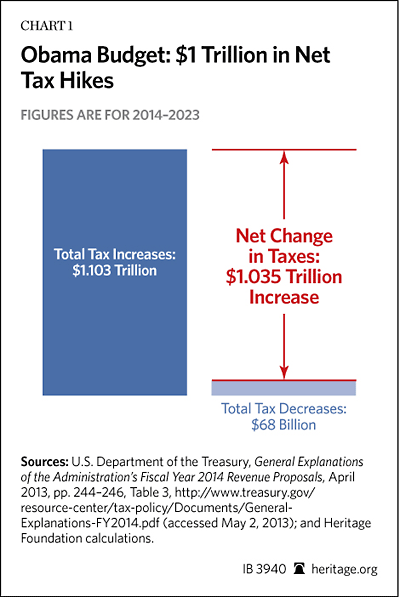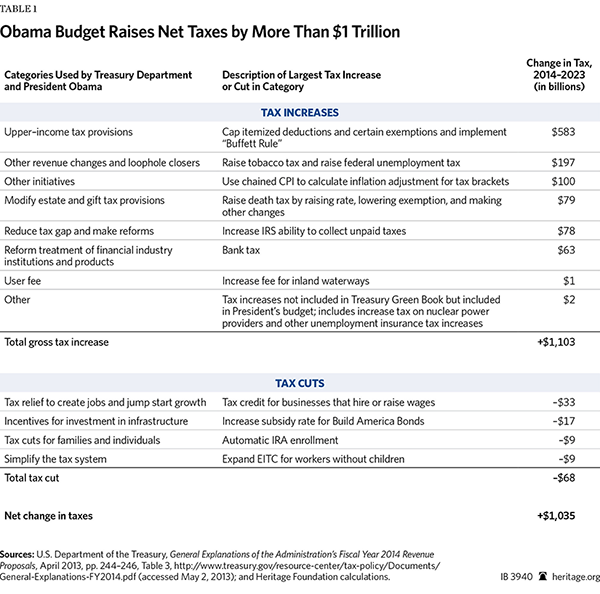President Obama released his fiscal year 2014 budget almost two months after it was due by law. With all that extra time, the President had plenty of opportunity to clearly account for his tax increases. But like his budgets from previous years, this year’s effort hides the total tax increase he proposes.[1]
For example, rather than put it with the other major tax increases in his budget, the President put the tax increase from changing the measure used to adjust tax brackets for inflation in a footnote.[2] Similarly, the President’s budget hides raising the federal tobacco tax from $1.00 per pack to $1.95 per pack in a section titled “Early Childhood Investments” because the revenue is supposed to pay for expanded preschool programs.
Fortunately, the Treasury Department, through its “Green Book,” groups the President’s tax increases in a consistent manner, which makes it easier to discern exactly how much he wants to raise taxes.[3]
Obama Budget Increases Taxes by More Than $1.1 Trillion
President Obama’s budget includes tax increases that total $1.103 trillion over the 10 years from 2014 to 2023. The Treasury groups his various tax increases into seven categories with vague headings.[4]
“Upper-income tax provisions” ($593 billion). The largest tax increase includes the President’s cap on itemized deductions and his infamous “Buffett Rule.”
The cap would limit the amount taxpayers could reduce their taxes by limiting their itemized deductions and certain exemptions to the tax reduction they would receive if they paid the 28 percent marginal tax rate (this raises taxes $529 billion). The cap would impose a tax penalty on giving to charity, taking a mortgage to buy a home, saving for retirement, buying state and municipal bonds, and having employer-sponsored health insurance, among others. Those penalties would apply to married taxpayers earning more than $223,050 ($183,250 for singles) in 2013.[5]
The Buffett Rule would impose a 30 percent effective tax rate on taxpayers with adjusted gross income (AGI) over $1 million ($500,000 for single filers), after allowing them to take the charitable deduction. As data from the Tax Policy Center shows, the Buffett Rule is already in effect because high-earners on average currently pay an effective tax rate on all federal taxes in excess of 30 percent.[6] This is why the Buffet Rule raises a comparably small amount of revenue ($53 billion).
“Other revenue changes and loophole closers” ($197 billion). The second-largest tax increase comes mostly from raising the tobacco tax ($78 billion) and raising the federal unemployment insurance tax ($67 billion). This category also includes the President’s ill-advised proposal to cap the total amount taxpayers can save in retirement savings plans.
The tobacco tax increase would hit poor smokers hardest. It would be the second time President Obama has targeted low-income Americans with a tobacco tax hike. He signed a previous increase just days after coming into office.
President Obama would raise the unemployment insurance tax by raising the rate and expanding the amount of each worker’s wages businesses had to pay the tax on. This would slow wage growth for workers since they ultimately bear most of the tax’s burden.
“Other initiatives” ($100 billion). The third-largest tax increase comes from changing how the tax code would adjust tax brackets for inflation each year. Currently the tax code uses the Consumer Price Index for All Urban Customers (CPI-U), which accounts for general changes in prices, to make those adjustments. President Obama wants to use chained CPI instead.
Chained CPI accounts for both changes in prices and how consumers change their behavior when prices rise—for instance, by purchasing less expensive substitute items when the price of something they bought previously rises. Because it accounts for behavioral changes, chained CPI produces a smaller measure of inflation than CPI-U.
Using chained CPI to adjust tax brackets for inflation would mean the brackets would increase less each year than they do now. This would raise taxes because it would push more income into higher tax brackets sooner. Congress should only move to chained CPI through tax reform. In tax reform it can offset the revenue chained CPI raises with pro-growth policies.
Death Tax Increase ($79 billion). The most surprising tax increase in Obama’s budget raises the death tax rate from 40 percent to 45 percent, decreases the amount of an estate exempt from the tax from $5 million to $3.5 million, and makes other changes that would make it more difficult for families to protect their businesses from the tax.
In the fiscal cliff deal in January, Obama signed into law the death tax’s current parameters. That deal raised the rate from 35 percent to the current 40 percent rate. Most thought the death tax was settled law for now. An even higher death tax would further hurt small, family-owned businesses and discourage families from saving and investing.
“Reduce the tax gap and make reforms” ($78 billion). This increase comes from granting the IRS more resources to collect unpaid taxes.
“Reform treatment of financial industry institutions and products” ($63 billion). This revenue is almost entirely from the President’s “Bank Tax.” Obama argues that the tax is necessary to recoup money from banks loaned to them by the federal government through the 2008 Troubled Asset Relief Program (TARP). However, the tax is unnecessary because banks have almost entirely repaid that money. [7]
Other ($3 billion). An increase of user fees for inland waterways ($1 billion) and other tax increases that the Green Book does not count but that are included in the President’s budget ($2 billion) account for the rest of Obama’s tax hikes.
Obama’s Budget Cuts Taxes by $68 Billion
Obama proposes new tax cuts totaling $68 billion over the next 10 years. That puts the ratio of tax increases to tax cuts in his budget at more than $16-to-$1.

“Tax relief to create jobs and jumpstart growth” (–$33 billion). The biggest tax cut category comes mostly from a proposed tax credit for businesses that hire workers and increase wages. It is similar to a tax credit previously tried in 2010 that failed to create jobs.[8] That credit failed because it did nothing to lower the long-term cost to businesses of hiring workers. The revived version would fail for the same reason.
“Incentives for investment in infrastructure” (–$17 billion). The next biggest tax cut comes mostly from an expansion of the federal subsidy for Build American Bonds.
“Tax cuts for families and individuals” (–$9 billion). This includes automatic enrollment in Individual Retirement Accounts (IRAs). Although it reduces revenue, it is not a tax cut because it encourages workers to use retirement savings plans already in law.[9] Adopting it would be a positive step for retirement policy.[10] The tax cut in this category comes almost exclusively from expanding the child and dependent care credit.[11]
“Simplify the tax system” (–$9 billion). The last tax cut grouping mostly consists of expanding the Earned Income Tax Credit (EITC) to workers without children.
Net Tax Increase in Obama’s Budget: $1.035 Trillion
Subtracting President Obama’s relatively miniscule tax cuts from his massive tax increases shows he wants to raise taxes on net by $1.035 trillion over the next 10 years. This enormous increase would slow the economy and job growth.
Fortunately, tax increases are unnecessary. As the Congressional Budget Office (CBO) shows, tax receipts will surpass their historical average as a share of the economy by 2015 and remain above that level through the decade.[12] Washington created its deficit and debt crisis because it is spending too much; not because it is taxing too little.
Congress should ignore the President’s tax increase proposals and focus on reducing spending instead.
—Curtis S. Dubay is a Senior Analyst in Tax Policy in the Thomas A. Roe Institute for Economic Policy Studies at The Heritage Foundation.



